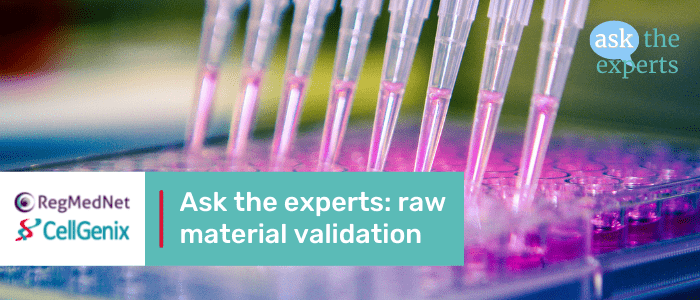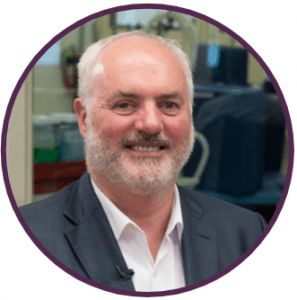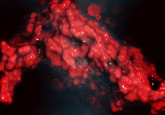Raw material validation: ask the experts

In this ‘Ask the experts’ feature, a panel of key thought leaders share their perspectives on current obstacles and future developments in raw materials. For example, how does raw material variation affect cell cultures and products? What challenges are associated with qualifying raw materials? What is the unmet need with currently available raw materials? Discover more about this from our expert panelists, Patricia Chimot-Marolle (Sartorius CellGenix; Freiburg, Germany), Frank Barry (National University of Ireland Galway), Kapil Bharti (National Institutes of Health; MD, USA) and Lyn Healy (Francis Crick Institute; London, UK).
Download this feature as a PDF
Raw material questions:
- Please introduce yourself and your institution
- How does raw material variation affect cell cultures and products?
- Which raw material characteristics are most important to monitor?
- What challenges are associated with qualifying raw materials?
- How is the quality of a raw material measured and guaranteed by the supplier?
- What quality and safety controls do manufacturers utilize to ensure raw material quality?
- How can you select a raw material manufacturer?
- What is the unmet need with currently available raw materials and how do you think they will evolve in the future to meet this?
Please introduce yourself and your institution.
Patricia Chimot-Marolle (PCM): My name is Patricia Chimot-Marolle and I am Senior Regulatory Affairs & Quality Support Manager at Sartorius CellGenix. Sartorius CellGenix is a leading global supplier of high quality raw and ancillary materials for the expanding market of cell and gene therapy and regenerative medicine.
Frank Barry (FB): My name is Frank Barry, and I am a Professor at the Regenerative Medicine Institute at the National University of Ireland Galway. Our institute has a focus on the development of cell-based strategies for the treatment of various diseases. Most of this effort relates to the use of mesenchymal stromal cells and also induced pluripotent stem cells. Our efforts range from fundamental research into how these cells are regulated through understanding their therapeutic mechanism, developing innovative manufacturing solutions and assessing their efficacy in clinical trials.
Kapil Bharti (KB): I am Kapil Bharti, Senior Investigator at the National Eye Institute, National Institutes of Health.
Lyn Healy (LH): My name is Lyn Healy and I look after the Human Embryo and Stem Cell Unit at the Francis Crick Institute. Our Institute is relatively new, and although we are in an academic setting, we have a great interest in translating our scientific findings. Indeed, in our strategic priorities it states that ‘we will explore opportunities for new and improved therapies, diagnosis and prevention strategies’. With this statement in mind, as academics we need to be engaged in promoting reproducible, robust science through standardization and this starts with the raw materials that we use, although we do not have the same constraints and regulatory compliance as colleagues working under cGMP in cell and gene therapy manufacturing.
How does raw material variation affect cell cultures and products?
PCM: Critical quality attributes of cells used in cell and gene therapy applications may not only be evaluated in terms of growth rates and viability but in relation to their capacity for differentiation, presence of specific surface markers or their ability to modulate an immune response. Variations in raw materials can affect these parameters. In particular, the quality of raw materials of biological origin (serum, human serum albumin or cytokines) or complex mixtures of many different components, like cell culture media, may be more susceptible to variability. Slight variations in impurity profiles (eg. trace elements content), composition or biological activity may lead to unwanted effects like lower expansion rates, or an altered surface marker profile of the cells.
It is therefore crucial to establish a production process in which all aspects are controlled, including the quality and source of raw materials, to ensure the desired output. Raw materials of consistent and reliable high quality, sourced from qualified suppliers, are therefore an essential prerequisite for the production of advanced therapy medicinal products (ATMPs).
FB: There are many important variables that have a profound impact on the manufacturing process, considering that, in cell therapy the product is a living cell, unlike a drug, biomolecule or device, and the phenotypic attributes of a cell are always sensitive to environmental changes. Therefore, if the culture conditions are altered, it is perfectly reasonable to expect the biological attributes of the cell product to be altered also. For example, changes in media composition, culture configuration, plastics, attachment factors, composition of gases etc., will all potentially have a profound effect.
KB: Raw material variation can have a huge impact on cell therapy products (CTP): variability in sterility testing can lead to contaminated CTP and harm patients; variability in purity can reduce yield or completed fail the CTP manufacturing process; and variability in documentation can lead to unwanted delay in CTP release.
LH: Raw material variation has a profound effect on all stages of the lifecycle involving human pluripotent stem cells. We can see the effects of these variations through morphological changes during cell line maintenance and via the propensity of the cells to differentiate robustly.
Which raw material characteristics are most important to monitor?
PCM: The most important raw material characteristics to monitor greatly depend on the intended use of the raw material and its function in the production process. Users should apply a risk-based approach to define the most important characteristics for each raw material. Raw materials should be fit for purpose, therefore, beyond properties like consistency, safety, identity and purity, the functionality also plays a great role in specifications and should be monitored. Release tests which are performed by the supplier should be good indicators of these parameters. The raw material manufacturer’s test for functionality may differ from the specific conditions at the end user’s production process, but they should be closely monitored and may serve as indicators for the consistency and high quality of a given raw material.
FB: Nothing is unimportant when it comes to raw materials for cell production. One of the most sensitive variables is probably the expansion medium used. The entire cell therapy industry still has an extraordinary reliance on the use of fetal bovine serum (FBS) for cell expansion. This is a staggering vulnerability because FBS is a highly complex, variable xenogeneic material, with a measurable risk of zoonosis. The supply of qualified, GMP grade FBS is unstable and there is a constant problem with enormous batch to batch variation. Labs that have carried out serum screens will be aware of the fact that the success rate is sometimes 1 in 5 or 1 in 10. Labs or production facilities that do not carry out a serum screen are exposing themselves to serious manufacturing risk.
KB: Raw material characteristics that are important to monitor include sterility, purity, potency, xeno-ingredients and shelf-life.
LH: We need to ensure that the raw materials are free from microbial contamination and endotoxin. In the case of cell culture media, we ensure that the media has been tested for Mycoplasma by the supplier since Mycoplasma contamination will alter the characteristics of the cells and have a detrimental effect on our human pluripotent stem cell work. In addition, we need to assess that the material we buy is fit for purpose and enables us to produce the same products in a reproducible manner each time we use it.
We also need the raw material to perform consistently from batch to batch.
What challenges are associated with qualifying raw materials?
PCM: Qualifying raw materials for ATMP production systems involves managing the technical challenge of controlling sensitive cell culture parameters, which can be influenced by many different factors. Limiting batch-to-batch variability is therefore crucial, especially for raw materials of biological origin.
What can also make raw material qualification complex is the difficulty in assessing the safety status of raw materials (exact composition, manufacturing techniques) from a user perspective. Indeed, the need to protect intellectual property can make exchanging information between the end user and the supplier more difficult. Confidentiality agreements can be implemented to help solve this challenge.
Finally, raw materials might not be available in the desired quality, or only as research grade materials. In these cases, qualification is more complex and supplier auditing is more critical, therefore, selecting high quality suppliers is a crucial part of raw material qualification.
FB: In the context of GMP production, every raw material and every supplier has to be qualified. This usually involves inspection or audit of the supplier to ensure that the facility is GMP-compliant. Frequently there will be a need for the manufacturer to validate the raw material in a series of tests according to standard operating protocols and these validation reports will form part of the manufacturing authorization. When the raw material is a biological substance such as FBS, or material extracted from human blood such as albumin, fibronectin or vitronectin, then there will always be challenges associated with the intrinsic variability of these materials. In addition, products such as human platelet lysate will be susceptible to variability as these are generally pooled. When the pool consists of a large number of donors there is less variability. At the same time this may lead to increased risk of disease transmission. So, there is a difficult balance to maintain.
KB: Qualification of new raw materials is associated with non-desired delays in manufacturing of CTP; increased cost of manufacturing; lost personnel time in qualification; and failed process for raw materials that are not high quality.
LH: When using a new raw material, you need to determine if the material is fit for the purpose that you intend to use it for. This is achieved by setting acceptance criteria and monitoring how the reagent performs. In our case through a number of standardized biological assays.
The development and performance of validated comparability assays to test batches of raw materials can be labor intensive and needs to be performed, in some cases, over a number of weeks before robust datasets, derived from a set of biological assays, can be produced and interpreted.
Reagents such as growth factors, present a challenge since different suppliers measure specific activity using different assay systems, therefore customers need to be aware that 100ug of a growth factor from one supplier might not be the same as 100ug of the same material from a second supplier. The use of reference materials could be of value in this situation.
How is the quality of a raw material measured and guaranteed by the supplier?
PCM: The first step to ensuring that requirements are met is the careful selection of materials used for production. Following a strict Animal-Derived Component Free (ADCF) policy for starting materials and production processes provides a high level of safety. In cases where this is not possible (eg. when serum or human proteins like HSA are required), it is strongly recommended to limit the presence and use of animal-derived materials in the raw material and in its production. In case animal-derived components have to be used, the risk of viral and TSE contamination should be mitigated by applying appropriate measures.
Another important consideration is the production under a suitable quality management system. In addition to an ISO 9001:2015 certification, the QM-system should follow relevant GMP guidelines. This ensures that qualified equipment is used, that personnel are adequately trained and processes and analytical methods are validated. For sterile products, a contamination control strategy which is in compliance with guidelines like the EU GMP guide Annex 1 should be in place.
FB: This will vary greatly depending on the specific nature of the raw material and it is impossible to generalize. For cell manufacturing, there is a wide diversity of materials, reagents, media and biological supplements. Each of these will require a specific series of tests. Common to all will be the need to demonstrate that each raw material is sterile.
KB: Suppliers typically measure and guarantee the quality of raw materials with in vitro potency assays, and by ensuring purity, sterility and that the materials lack xeno ingredients. Suppliers should also provide documentation for sourcing, and proper documentation for sterility, purity and shelf-life.
LH: Most of the raw materials that we use are from commercial suppliers who provide us with a certificate of analysis for the batches of materials that they supply. These certificates will include information on the acceptance criteria that their quality control department considers important before releasing each batch to the customer.
What quality and safety controls do manufacturers utilize to ensure raw material quality?
PCM: Raw material manufacturers constantly develop their knowledge of their product and this usually means that they apply a thorough selection of suppliers and control of raw materials. In particular, following strict ADCF policies whenever possible is very important to control the safety of a raw material.
The next obvious step would be the control of production processes. Producing under a GMP environment (though certification is not possible) is an important criterion for controlling product quality and safety.
Compliance with the relevant regulations, in particular compliance with US Pharmacopeia (USP) monographs or European Pharmacopeia (EP) monographs and ISO Technical Standard are good indicators that the manufacturer is producing a high-quality raw material. Analytical methods should, whenever possible, be performed according to EP or USP requirements and international standards should be used to calibrate assays. Stability studies should be performed to ensure consistent quality during the shelf life of the raw material.
FB: Manufacturers will take great care to ensure the quality and safety of the raw materials that they utilize. In general, they will carry out their own inspections to determine that the raw material manufacturing facility is within approved specification. The cell therapy manufacturer will devote considerable resources to this and may well establish a vendor management program as part of its quality management systems. This will embrace quality audit of vendors and establishment of a bill of materials with quality specifications for all.
KB: To ensure raw material quality, manufacturers should qualify vendors, evaluate complete documentation (CoA, CoO) associated with each raw material, and assess raw material shelf-life and potency in manufacturing process.
LH: The manufacturers that we use have quality management systems in place and a number of them work to GMP or have ISO accreditation to one or more standards.
With respect to safety, suppliers will provide customers with Safety Data Sheets (SDS) which provide information on the properties and hazards specific to the raw material being handled. It is written in a standard format and comprises a number of sections including first aid measures and disposal considerations.
How can you select a raw material manufacturer?
PCM: An ISO 9001:2015 certification is a clear indication that a quality management system is in place. This certification should be considered a requirement for the production of raw materials. Audits can also be helpful to evaluate raw material manufacturers. Despite the complicated period of the pandemic, many companies offer remote audits which are not an exception anymore. These audits are not only an opportunity to qualify the supplier in terms of your own quality standards, but also check the communication and reactivity of the supplier. Additionally, it is an opportunity to build trust and a good basis for partnership.
It is not possible to consider the selection of raw material manufacturers without taking regulatory requirements into account. In the USA it is clearly of advantage to use products which have Drug Master Files (DMFs). A similar DMF system is also established in Japan. Thinking globally and for international markets, choosing companies with international experience and providing regulatory support can make a big difference.
FB: Raw materials for GMP production usually represent a very high proportion of the production cost and selection of the vendor is a critical step. Among the most important points to consider are the reliability of the vendor and continuity of supply. If a raw material is discontinued or disqualified this can have a serious or sometimes fatal impact on the cell manufacturing campaign. This happens more often than it should.
KB: The ability to provide proper raw material documentation (CoA and CoO) is important when selecting a raw material manufacturer. If needed, allow a site audit and, if asked, provide vendor supply agreements.
LH: Knowing that a supplier has a robust, audited quality management system is a fundamental requirement.
Confidence that the supplier will inform you of any changes in source, quality, performance and availability of raw materials is also key.
Over the years I have been privileged to work closely with companies such as Thermo Fisher (MA, USA) and STEMCELL Technologies (Vancouver, Canada) in their development and testing of reagents. I believe that being able to interact with the supplier in a responsive manner is very important and leads to a better understanding of the issues that need to be addressed by both parties.
It is also important to ensure that you have an alternative supplier of key reagents if possible. When using alternative reagents, these should be validated prior to application to ensure that robustness and reproducibility are not compromised when reagents are substituted in a process. This situation may arise if the supply of a raw material is interrupted for a period of time.
What is the unmet need with currently available raw materials and how do you think they will evolve in the future to meet this?
PCM: The manufacture of cell and gene therapies (CGT) is particularly sensitive and requires a comprehensive understanding of the raw materials used in the manufacturing process to ensure a safe, efficacious and high-quality product. The manufacturing of raw materials for CGT manufacturing is however not well regulated and is not supervised by any health authority. Despite arising guidance in this area, existing guidelines are, essentially, recommendations rather than guidelines. Geographical discrepancies make regulatory considerations even more complex. An additional challenge arises from the fact that all current regulations and guidance documents are not aimed at the manufacturers of the raw materials. Instead, they assign ultimate responsibility for quality and suitability of the raw materials to the user, the CGT manufacturer. Therefore, standardization of quality requirements of raw materials would bring much needed regulatory harmonization. We are working with different workgroups in order to ultimately set global quality standards for raw materials for CGT manufacturing. Until such quality standards are set, CGT manufacturers need to work in close cooperation with their supplier to get the necessary support.
FB: The major point here is probably the over-reliance on xenogeneic products, i.e., materials of animal origin. The industry still has a major vulnerability in this regard. The unmet need of therefore the utilization of xeno-free raw materials from start to finish.
KB: There are numerous challenges currently associated with raw materials. There are not enough options for GMP raw materials, an insufficient number of suppliers for high quality GMP raw materials and there are often back orders, even from regular suppliers, which causes undesired delays. Vendors do not provide sufficient documentation on a raw material and are not willing to do supply agreements. In addition to this, the raw materials themselves have a limited shelf-life.
Slowly the landscape of this field is changing. There are multiple suppliers for some raw materials. This increased competition will lead to suppliers improving their delivery options, being stricter about sourcing and other paperwork. Suppliers still need to design raw material with better shelf-lives.
LH: This is a difficult question to address from the academic point of view as in general most of our reagents are ‘off the shelf’ and we often have the luxury of choice for many of the reagents that we use. Moving into translation from the academic setting, I think that we in academia need to become more aware of the concept of traceability of raw materials and promote robust record keeping, capturing the attributes of these materials and the processes that they are utilized in. This will facilitate standardization, enabling a smooth transition between academia and manufacture. In the area of human pluripotent stem cells, we have a number of suppliers who provide reagents manufactured to cGMP to enable the development of processes that can then be adopted and revalidated in a manufacturing setting.
I also think that the lack of reference materials in the areas of gene and cell therapy is an important area to be addressed.
Meet the experts
Patricia Chimot-Marolle | Senior Regulatory Affairs & Quality Support Manager at Sartorius CellGenix (Freiburg, Germany)
Patricia Chimot-Marolle is the Senior Regulatory Affairs & Quality Support Manager at Sartorius CellGenix. Sartorius CellGenix is a leading global supplier of high quality raw and ancillary materials for the expanding market of cell and gene therapy and regenerative medicine.
Frank Barry | Professor of Cellular Therapy at the Regenerative Medicine Institute, National University of Ireland Galway (Ireland)
Frank Barry is Professor of Cellular Therapy at the Regenerative Medicine Institute, National University of Ireland Galway (Ireland) and Visiting Scientist at the Schroeder Arthritis Institute in Toronto (Canada). He has contributed to the fields of tissue engineering and regenerative medicine by developing innovative and successful cellular therapies for tissue repair, joint injury and arthritic disease. In a large body of basic and translational research, he has contributed to our current understanding of the phenotypic attributes of mesenchymal stromal cells that make them attractive candidates for advanced therapeutics. He has also contributed to the development of methods for automated, efficient and scalable cell expansion for GMP application and has been a leader in the development of clinical protocols for patient testing. He is the Coordinator of the ADIPOA2 clinical trial to test the efficacy of stromal cell delivery as a treatment for osteoarthritis. Frank Barry has been the recipient of the Marshall Urist Award for excellence in tissue regeneration research from the Orthopaedic Research Society. He was recently elected as a Member of the Royal Irish Academy.
Kapil Bharti | Senior Investigator at the National Eye Institute, National Institutes of Health (MD, USA)
Kapil Bharti holds a bachelor’s degree in biophysics from the Panjab University in Chandigarh, India, where he graduated with highest honors. This was followed by a master degree in biotechnology at the Maharaja Sayaji Rao University in Baroda, India and a diploma in molecular cell biology at the Johann Wolfgang Goethe University at Frankfurt in Germany. Supported by an international Ph.D. student fellowship, he obtained his Ph.D. from the same institution, graduating summa cum laude. His Ph.D. work involved basic biology in the areas of heat stress, cellular chaperones, and epigenetics. From Germany, Kapil Bharti came to the National Institute of Neurological Disorders and Stroke to work with Heinz Arnheiter as a postdoctoral fellow. While there, he published numerous papers in the areas of transcription factor regulation, pigment cell biology, and the developmental biology of the eye. It is perhaps this combination of diverse backgrounds that led him to develop an interest in the emerging field of stem cell biology, particularly of the retinal pigment epithelium, as he moved into the role of staff scientist. Dr. Bharti has authored numerous publications and has won several awards, including, most recently, being a finalist in the prestigious trans-NIH Earl Stadtman Symposium.
Lyn Healy | Human Embryo and Stem Cell Unit, Francis Crick Institute (London, UK)
Disclaimers
The opinions expressed in this interview are those of the interviewees and do not necessarily reflect the views of RegMedNet or Future Science Group.
This feature was produced in association with Sartorius CellGenix.






